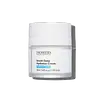What's inside
What's inside
 Key Ingredients
Key Ingredients

 Benefits
Benefits

 Concerns
Concerns

 Ingredients Side-by-side
Ingredients Side-by-side

Water
Skin ConditioningCetearyl Alcohol
EmollientCaprylic/Capric Triglyceride
MaskingDimethicone
EmollientEctoin
Skin ConditioningGlyceryl Glucoside
HumectantUrea
BufferingOenothera Biennis Oil
EmollientAminobutyric Acid
Spirodela Polyrhiza Extract
Skin ConditioningSaccharomyces Lysate Filtrate
Skin ProtectingGlycerin
HumectantPanthenol
Skin ConditioningGlyceryl Acrylate/Acrylic Acid Copolymer
Humectant1,2-Hexanediol
Skin ConditioningPhenyl Trimethicone
Skin ConditioningHydroxyacetophenone
AntioxidantPropylene Glycol
HumectantDimethicone Crosspolymer
Emulsion StabilisingCeteareth-20
CleansingPolysorbate 60
EmulsifyingWater, Cetearyl Alcohol, Caprylic/Capric Triglyceride, Dimethicone, Ectoin, Glyceryl Glucoside, Urea, Oenothera Biennis Oil, Aminobutyric Acid, Spirodela Polyrhiza Extract, Saccharomyces Lysate Filtrate, Glycerin, Panthenol, Glyceryl Acrylate/Acrylic Acid Copolymer, 1,2-Hexanediol, Phenyl Trimethicone, Hydroxyacetophenone, Propylene Glycol, Dimethicone Crosspolymer, Ceteareth-20, Polysorbate 60
Water
Skin ConditioningGlycerin
HumectantSqualane
EmollientShorea Stenoptera Seed Butter
EmollientCaprylic/Capric Triglyceride
MaskingC12-16 Alcohols
EmollientSodium Acrylates Copolymer
Ectoin
Skin ConditioningJojoba Esters
EmollientPalmitic Acid
EmollientPhenoxyethanol
PreservativeHydrogenated Lecithin
EmulsifyingHydroxyethyl Acrylate/Sodium Acryloyldimethyl Taurate Copolymer
Emulsion StabilisingLecithin
EmollientMagnesium Chloride
Ethylhexylglycerin
Skin ConditioningSodium Gluconate
Skin ConditioningCaprylyl Glycol
EmollientAcetyl Hexapeptide-8
HumectantWater, Glycerin, Squalane, Shorea Stenoptera Seed Butter, Caprylic/Capric Triglyceride, C12-16 Alcohols, Sodium Acrylates Copolymer, Ectoin, Jojoba Esters, Palmitic Acid, Phenoxyethanol, Hydrogenated Lecithin, Hydroxyethyl Acrylate/Sodium Acryloyldimethyl Taurate Copolymer, Lecithin, Magnesium Chloride, Ethylhexylglycerin, Sodium Gluconate, Caprylyl Glycol, Acetyl Hexapeptide-8
 Reviews
Reviews

Ingredients Explained
These ingredients are found in both products.
Ingredients higher up in an ingredient list are typically present in a larger amount.
This ingredient is an emollient, solvent, and texture enhancer. It is considered a skin-softener by helping the skin prevent moisture loss.
It helps thicken a product's formula and makes it easier to spread by dissolving clumping compounds.
Caprylic Triglyceride is made by combining glycerin with coconut oil, forming a clear liquid.
While there is an assumption Caprylic Triglyceride can clog pores due to it being derived from coconut oil, there is no research supporting this.
Learn more about Caprylic/Capric TriglycerideEctoin is a compound found naturally in some species of bacteria. It can be synthetically created for skincare use.
This ingredient is an osmolyte; Osmolytes help organisms survive osmotic shock (it protects them from extreme conditions). It does this by influencing the properties of biological fluids within cells.
When applied to the skin, ectoin helps bind water molecules to protect our skin. The water forms a sort of armor for the parts of our skin cells, enzymes, proteins, and more.
Besides this, ectoin has many uses in skincare:
A study from 2004 found ectoin to counteract the damage from UV-A exposure at different cell levels. It has also been shown to protect skin against both UV-A, UV-B rays, infrared light, and visible light.
Studies show ectoin to have dual-action pollution protection: first, it protects our skin from further pollution damage. Second, it helps repair damage from pollution.
In fact, ectoin has been shown to help with:
Fun fact: In the EU, ectoin is used in inhalation medication as an anti-pollution ingredient.
Ectoin is a highly stable ingredient. It has a wide pH range of 1-9. Light, oxygen, and temperature do not affect this ingredient.
Learn more about EctoinGlycerin is already naturally found in your skin. It helps moisturize and protect your skin.
A study from 2016 found glycerin to be more effective as a humectant than AHAs and hyaluronic acid.
As a humectant, it helps the skin stay hydrated by pulling moisture to your skin. The low molecular weight of glycerin allows it to pull moisture into the deeper layers of your skin.
Hydrated skin improves your skin barrier; Your skin barrier helps protect against irritants and bacteria.
Glycerin has also been found to have antimicrobial and antiviral properties. Due to these properties, glycerin is often used in wound and burn treatments.
In cosmetics, glycerin is usually derived from plants such as soybean or palm. However, it can also be sourced from animals, such as tallow or animal fat.
This ingredient is organic, colorless, odorless, and non-toxic.
Glycerin is the name for this ingredient in American English. British English uses Glycerol/Glycerine.
Learn more about GlycerinWater. It's the most common cosmetic ingredient of all. You'll usually see it at the top of ingredient lists, meaning that it makes up the largest part of the product.
So why is it so popular? Water most often acts as a solvent - this means that it helps dissolve other ingredients into the formulation.
You'll also recognize water as that liquid we all need to stay alive. If you see this, drink a glass of water. Stay hydrated!
Learn more about Water